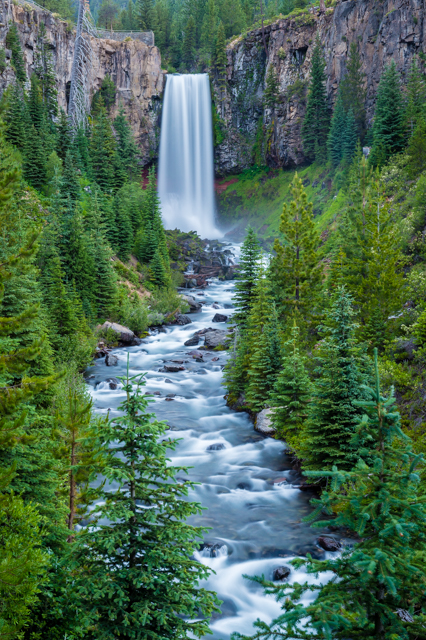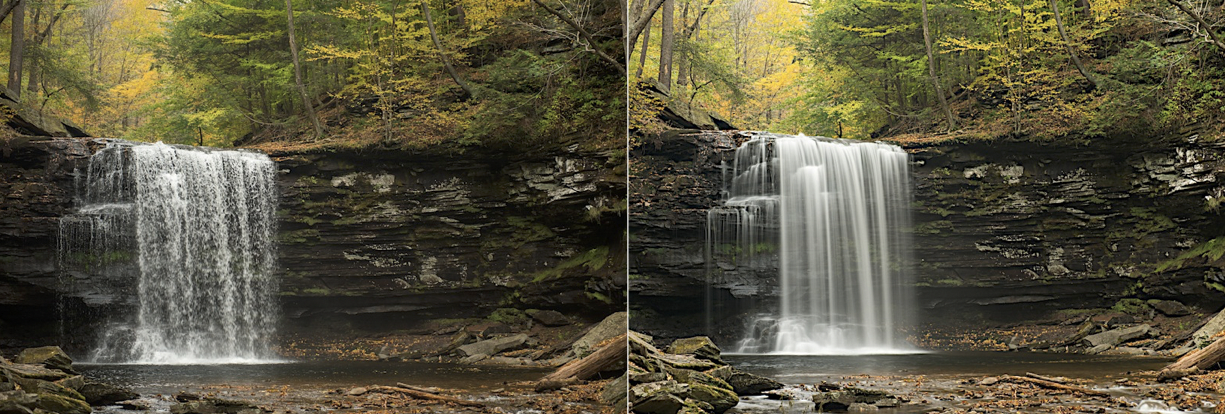Tips for Photographing Waterfalls
March 28, 2019 by Marie Joabar
 Spring is typically the best time to photograph waterfalls. The melting snow and the season’s rains increase the flow and volume of the streams and rivers making them more powerful than at any other time of the year.
Spring is typically the best time to photograph waterfalls. The melting snow and the season’s rains increase the flow and volume of the streams and rivers making them more powerful than at any other time of the year.
TIME OF DAY - The trickiest part of shooting waterfalls is properly exposing for both the white flowing water in the falls and the darker forest area surrounding it. This is especially the case when the sun is overhead casting harsh shadows in the gorge or basin while at the same time striking the falls and rendering them totally white and lacking in detail. The range of contrast between highlights and shadows is too great to expose for one without the other being over exposed or lost in shadow.
- To avoid this shoot in the early evening with the orange glow of the late day sun, or very early with the warm morning light before the sun rises too high.
- Morning also presents the opportunity to capture mist or fog rising from the falls which can make them look almost magical.
- Take advantage of a cloudy or overcast day when the light is diffused and there are no harsh shadows.
FAST OR SLOW - In some photographs, we see the water in the falls with a silky, almost cotton-candy look to it. In others, the flowing water is frozen and we see water droplets suspended in mid air. This is the choice of the photographer. There’s no right or wrong way and no rule about how the water should look. The two different styles are explained below, try shooting both and see which you prefer.
- THE SLOW & SILKY LOOK - The silky looking water is a result of using a very slow shutter speed. Just HOW slow depends on the volume of the water and how fast it is flowing. The lighter the volume and the slower the flow, the longer the shutter speed should be to achieve this look.
- Set the camera on manual (M) and select a slow shutter speed somewhere between 1/5th of a second to 3 full seconds as a starting point. Select a small aperture (large f-stop number) such as f22 to avoid over-exposing the image.
- Take a photo then check the histogram in playback. Make sure the graph isn’t going off the chart on the far right side. This would indicate there is no detail in the highlight areas; the result is water that looks like a solid white blob.
- Many times, even stopping the lens down to f22 is not enough to prevent overexposure. To correct for this, consider using a Neutral Density filter (ND). These filters reduce the light entering the camera and allow for the use of the slow shutter speeds that make the water look like a silky veil flowing over boulders as it flows downstream. A 2X and a 4X ND filter can be used separately or together if needed, they can also be stacked with a circular polarizing filter. Many times, it takes using all of them to cut the light enough to allow for the slower shutter speeds.
- A sturdy tripod is essential in order to capture the frothy looking water. Together with a tripod, a cable release or the camera’s remote timer is necessary as simply depressing the shutter can cause the camera to vibrate and cause blurring.
- CAPTURE THE FALLS FAST & FURIOUS - To show the falls as a powerful force and freeze the flow of the water use a fast shutter speed.
- In either Manual (M) or Shutter Priority (S, or TV if Canon), set the shutter speed to 1/125 or 1/250 of a second as a starting point. Adjust to a faster shutter speed if needed depending on the volume and speed of the falls.
- If using Shutter Priority, you'll choose the shutter speed and the camera will select the aperture accordingly.
- If using the manual mode set the aperture to f8 or f11 which should give enough depth of field to capture the falls together with some foreground interest such as boulders in the water, or ferns, or greenery near the base of the falls.
- In playback, refer to the histogram and check for blown-out highlights. If this is the case, further reduce the light entering the camera; use a faster shutter speed, a smaller aperture or a ND filter.
- Regardless of a fast or slow shutter speed, the ISO (the sensor’s sensitivity to light) should be set to 100 or 200.
 LENS CHOICES - Any range of lenses from a focal length of 12mm to 300mm will work for capturing waterfalls. Which to use depends on how far away the falls are and how much of the surrounding area is to be included in the scene. A wide angle lens (anything below 50mm) will allow a lot to fit into the scene from the sky above to the boulders at the base. A telephoto lens, (anything above 50 mm) allows for greater magnification, useful if the falls are off in the distance and not accessible. Telephotos can also be fun for zooming in and isolating just a portion of the falls.
LENS CHOICES - Any range of lenses from a focal length of 12mm to 300mm will work for capturing waterfalls. Which to use depends on how far away the falls are and how much of the surrounding area is to be included in the scene. A wide angle lens (anything below 50mm) will allow a lot to fit into the scene from the sky above to the boulders at the base. A telephoto lens, (anything above 50 mm) allows for greater magnification, useful if the falls are off in the distance and not accessible. Telephotos can also be fun for zooming in and isolating just a portion of the falls.
COMPOSITION - Vertical framing accentuates the height of long and narrow waterfalls while shorter wider waterfalls look better in a horizontal frame. To be safe, capture it both ways. In fact, shoot the falls from every angle-up high, down low, horizontal and vertical. In some shots, include the entire falls, in others, frame them without a portion of the top or bottom to spark the viewer’s imagination.
SEASONS - Athough the water flow is the heaviest in the Spring, it’s definitely worth return to the falls in different seasons.
- Winter snow and icicles can be gorgeous - just take care getting to the falls if icy.
- Autumn provides an opportunity to frame the waterfalls in the brilliant color of fall leaves which is often reflected in the pools at the base as well.
- It’s a treat during the summer to visit the falls of smaller rivers and streams which offer pools safely downstream for jumping into.
WHERE THE FALLS ARE - Great Falls Park is just 15 miles from the District and terrific views of the Potomac River falls can be found on both the Maryland and Virginia side. Waterfalls worth hiking to in Virginia’s Shenandoah National Park are Lewis Falls, Dark Hollow Falls, Rose River Falls, and the many falls of the White Oak Canyon (just to name a few). Maryland offers Cunningham Falls in Frederick County and many others in Garrett County.
Regardless of the season, find a friend or fellow hiker and venture off to find and photograph one of the area's unique waterfalls.
